Coole Park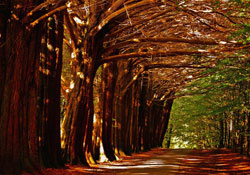 Coole Park outside Gort in County Galway was the home of Lady Augusta Gregory, dramatist and co-founder with Edward Martyn and W.B. Years of the Abbey Theatre. The area is also a National Nature Reserve due to its great wildlife importance – its native woodlands and turloughs.The visitor centre uses multimedia presentations, models, exhibitions and audio visual to inform the visitor of both the natural and literary heritage of the area.
Coole Park outside Gort in County Galway was the home of Lady Augusta Gregory, dramatist and co-founder with Edward Martyn and W.B. Years of the Abbey Theatre. The area is also a National Nature Reserve due to its great wildlife importance – its native woodlands and turloughs.The visitor centre uses multimedia presentations, models, exhibitions and audio visual to inform the visitor of both the natural and literary heritage of the area.
Gregory Museum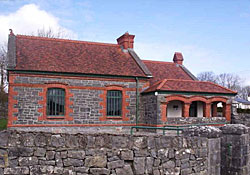 The Kiltartan Gregory Museum and Millennium Park is located two miles outside Gort on the main Galway Road at the historic spot “Kiltartan Cross” where the blind poet Rafferty met and fell in love with the “Beauty of Ballylee” Márre ní hEidhie and often played music for local dances.
The Kiltartan Gregory Museum and Millennium Park is located two miles outside Gort on the main Galway Road at the historic spot “Kiltartan Cross” where the blind poet Rafferty met and fell in love with the “Beauty of Ballylee” Márre ní hEidhie and often played music for local dances.
This building was a National School built in 1892 at the behest of the local landlord, Sir William Gregory of Coole Park, Gort. The architect, Francis Persse was his brother-in-law and he incorporated into the building, the ornamental portions with which Sir William was familiar, when he was Governor of Ceylon. The school was closed in 1960 and was acquired by the local branch of the Irish Farmers Association. Restoration began in 1990 with the formation of the Kiltartan Gregory Cultural Society and assistance from Government Agencies and the Local Fundraising. The Museum was officially opened by Mary Robinson on the 8th August, 1996.
Thoor Ballylee, home of W.B. Yeats
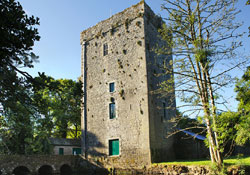 Thoor Ballylee was Yeats’s monument and symbol; in both aspects it had multiple significance. It satisified his desire for a rooted place in a known countryside, not far from Coole and his life-long friend Lady Gregory.To live in a Tower complemented, perhaps, his alignment with a tradation of cultivated aristocracy which he had envied and a leisured peace which he had enjoyed.
Thoor Ballylee was Yeats’s monument and symbol; in both aspects it had multiple significance. It satisified his desire for a rooted place in a known countryside, not far from Coole and his life-long friend Lady Gregory.To live in a Tower complemented, perhaps, his alignment with a tradation of cultivated aristocracy which he had envied and a leisured peace which he had enjoyed.
The tower or castle that Yeats bought was a sixteeneth century norman castle built by the family de Burgo, or Burke. It consisted of four floors with one room on each, connected by a spiral stone stairway built into the seven-foot thickness of the massive outer wall. Each floor had a window overlooking the river which flowed alongside. At the top here was a flat roof reached by a final steep flight of steps from the floor below.
Kilmacduagh Monastery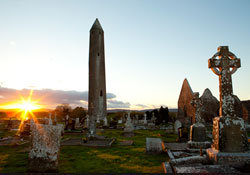 Close to and easily accessible from Gort, this interesting early Christian site is well worth a visit for its ruined churches and well preserved round tower. The monastery was founded in the 7th Century by St. Colman MacDuagh under the patronage of Guaire, King of Connacht, although, except for the tower, most of the present buildings date from the 13th – 14th centuries. The name Kilmacduagh roughly translates as “church of Duagh’s son”.
Close to and easily accessible from Gort, this interesting early Christian site is well worth a visit for its ruined churches and well preserved round tower. The monastery was founded in the 7th Century by St. Colman MacDuagh under the patronage of Guaire, King of Connacht, although, except for the tower, most of the present buildings date from the 13th – 14th centuries. The name Kilmacduagh roughly translates as “church of Duagh’s son”.
This site was of such importance that it became the centre of a new diocese, the Diocese of Kilmacduagh, in the 12th century; it is now incorporated into the Diocese of Galway. The monastery, because of its wealth and importance, was plundered several times in the lawless years of the 13th century. The interesting stonework features scattered throughout the small churches are worth searching for; these are mostly inserts from the late 11th to the 15th centuries. The Reformation effectively brought the religious life of Kilmacduagh to a close.
Dunguaire Castle Dunguaire Castle is a small 17th century castle on a rocky promontory, situated just outside the picturesque village of Kinvara on the shores of Galway Bay. This castle was built 500 years ago in an inspirational place commanding the shores of the majestic Galway Bay ~ situated 300 yards outside Kinvara Village. It is famed in song and story even this day. The castle is 500 years old and in that time has had a chequered history.
Dunguaire Castle is a small 17th century castle on a rocky promontory, situated just outside the picturesque village of Kinvara on the shores of Galway Bay. This castle was built 500 years ago in an inspirational place commanding the shores of the majestic Galway Bay ~ situated 300 yards outside Kinvara Village. It is famed in song and story even this day. The castle is 500 years old and in that time has had a chequered history.
Dunguaire was built in 1520 by the O’Hynes clan, and is situated on the picturesque shores of Galway Bay. The Castle takes it name from the nearby ancient fort of Guaire, King of Connaught who died is 662 AD. This restored 16th century tower house sits on a rocky outcrop on the shores of Galway Bay, 300 yards outside the picturesque village of Kinvara.
The Burren The Burren is a unique area of 270 sq. kilometres of limestone pavement and green valleys. It is rich in flora and fauna, geology, archaeology, ancient settlements and ecclesiastical sites. Man has settled here for at least six thousand years and the area has the largest concentration of stone forts, monuments and ecclesiastical sites in Ireland. Botanists come from all over the world to study the flora. Uniquely, Mediterranean, alpine and arctic flowers and plants grow side by side, the seeds having been deposited by glacier millions of years ago. This is the mystical land of disappearing rivers and lakes, closed valleys, caves and limestone pavement. www.burrenbeo.com
The Burren is a unique area of 270 sq. kilometres of limestone pavement and green valleys. It is rich in flora and fauna, geology, archaeology, ancient settlements and ecclesiastical sites. Man has settled here for at least six thousand years and the area has the largest concentration of stone forts, monuments and ecclesiastical sites in Ireland. Botanists come from all over the world to study the flora. Uniquely, Mediterranean, alpine and arctic flowers and plants grow side by side, the seeds having been deposited by glacier millions of years ago. This is the mystical land of disappearing rivers and lakes, closed valleys, caves and limestone pavement. www.burrenbeo.com
Gort Golf Club Designed by Ryder Cup star, Christy O’ Connor Junior, and officially opened in August 1996, Gort Golf Club is an 18 Hole Championship Golf Course, set in 160 acres of picturesque parkland on the edge of the world famous Burren and within 200 yards of the historic monastic settlement of Kilmacduagh. www.gortgolf.com
Designed by Ryder Cup star, Christy O’ Connor Junior, and officially opened in August 1996, Gort Golf Club is an 18 Hole Championship Golf Course, set in 160 acres of picturesque parkland on the edge of the world famous Burren and within 200 yards of the historic monastic settlement of Kilmacduagh. www.gortgolf.com
Gort
Nearest town to Coole Lodge (1.5 miles). Further information available at www.gortonline.com
Kinvara
Just 7 miles from Coole Lodge, Kinvara is a picturesque seaside village. More information available at www.kinvara.com
Ailwee Caves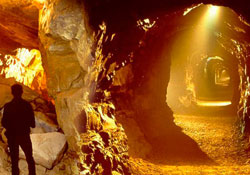 This stunning creation of nature was formed by the melt waters of a prehistoric ice age. The cave, carved out of limestone, cuts into the heart of the mountain. The name Aillwee is derived from the Irish Aill Bhuí which means “yellow cliff”. www.aillweecave.ie
This stunning creation of nature was formed by the melt waters of a prehistoric ice age. The cave, carved out of limestone, cuts into the heart of the mountain. The name Aillwee is derived from the Irish Aill Bhuí which means “yellow cliff”. www.aillweecave.ie
 Cliffs of Moher
Cliffs of Moher
The most dramatic cliffs in Europe (250 metres) and home to a myriad of wildlife, many different species of birds, dolphins and the occasional whale. Beautiful views towards the Aran Islands and Connemara. There is a long cliff side walk for those who wish to brave the brisk Atlantic breeze. On your way back, take the scenic coastal road to Ballyvaughan via Black Head.
Aran Islands
These are a group of three islands off the coast of Galway & Clare. They are well known for their cultural and literary history as well as their traditional way of life. Islanders still speak Irish as their first language. Ferries depart each morning from Doolin (in Clare) and Galway & Rossaveal.
